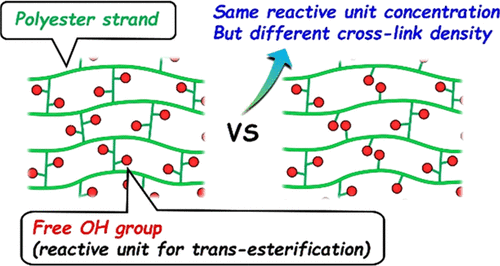当前位置:
X-MOL 学术
›
Macromolecules
›
论文详情
Our official English website, www.x-mol.net, welcomes your
feedback! (Note: you will need to create a separate account there.)
Fair Investigation of Cross-Link Density Effects on the Bond-Exchange Properties for Trans-Esterification-Based Vitrimers with Identical Concentrations of Reactive Groups
Macromolecules ( IF 5.1 ) Pub Date : 2019-12-19 , DOI: 10.1021/acs.macromol.9b01896 Mikihiro Hayashi 1 , Ryoto Yano 1
Macromolecules ( IF 5.1 ) Pub Date : 2019-12-19 , DOI: 10.1021/acs.macromol.9b01896 Mikihiro Hayashi 1 , Ryoto Yano 1
Affiliation

|
In this research, we demonstrate effects of cross-link density on the bond-exchange property of trans-esterification-based vitrimers. In most of the past literature, the change of cross-link density is inevitably accompanied by the change of concentration of reactive groups, which disturbs extraction of pure effects of cross-link density. For pursuing fair comparison, the concentrations of free OH groups (i.e., the reactive group for trans-esterification) and catalysts are here kept the same among samples with different cross-link densities. This is achieved by using an amorphous low-Tg polyester possesing multiple COOH side groups (PE-COOH), di-epoxy compound (1,4-butanediol diglycidyl ether), and mono-epoxy compound (butyl glycidyl ether). The di-epoxy acts as a cross-linker agent that reacts with COOH groups in PE-COOH, while the mono-epoxy reacts but does not work as the cross-linker, and thus the cross-link density can be tuned by the fraction of the di-epoxy compound (fdi-epoxy) in the total epoxy compounds. Importantly, both epoxy compounds generate a free OH group in reacting with COOH, and thus the change of fdi-epoxy is not accompanied by the change of the free OH concentration in the system. Rheological measurements and tensile tests first reveal the systematic tuning of cross-link density depending on fdi-epoxy. We then investigate effects of the cross-link density on the stress-relaxation rate at high temperatures and activation energy (Ea) for the bond exchange, revealing an interesting phenomenon, that is, the fastest relaxation rate and the lowest Ea for the largest cross-link density sample. The results are discussed in terms of entropically driven acceleration of bond exchange for the perturbed network segments.
中文翻译:

交联密度对反应基团浓度相同的基于反酯化的Vitrimers的键交换性能的公平研究
在这项研究中,我们证明了交联密度对基于酯交换的tritrimers的键交换性能的影响。在过去的大多数文献中,交联密度的变化不可避免地伴随着反应性基团浓度的变化,这干扰了交联密度纯作用的提取。为了进行公平的比较,在具有不同交联密度的样品中,游离OH基团(即用于酯交换反应的反应性基团)和催化剂的浓度应保持相同。这是通过使用非晶态低T g来实现的。具有多个COOH侧基的聚酯(PE-COOH),二环氧化合物(1,4-丁二醇二缩水甘油醚)和单环氧化合物(丁基缩水甘油醚)。二环氧充当与PE-COOH中的COOH基团反应的交联剂,而单环氧反应但不充当交联剂,因此可以通过分数调节交联密度总环氧化合物中二环氧化合物(f di-epoxy)的含量。重要的是,两种环氧化合物在与COOH反应时都会生成一个游离的OH基团,因此f二环氧的变化不会伴随着系统中游离OH浓度的变化。流变学测量和拉伸测试首先揭示了取决于f的交联密度的系统调节双环氧。然后,我们探讨在高温和活化能(应力松弛率的交联密度的影响Ë一对债券交换),揭示了一个有趣的现象,那就是最快的弛豫率和最低Ë一对最大的交联密度样品。根据扰动网络段的熵驱动键交换的加速来讨论结果。
更新日期:2019-12-20
中文翻译:

交联密度对反应基团浓度相同的基于反酯化的Vitrimers的键交换性能的公平研究
在这项研究中,我们证明了交联密度对基于酯交换的tritrimers的键交换性能的影响。在过去的大多数文献中,交联密度的变化不可避免地伴随着反应性基团浓度的变化,这干扰了交联密度纯作用的提取。为了进行公平的比较,在具有不同交联密度的样品中,游离OH基团(即用于酯交换反应的反应性基团)和催化剂的浓度应保持相同。这是通过使用非晶态低T g来实现的。具有多个COOH侧基的聚酯(PE-COOH),二环氧化合物(1,4-丁二醇二缩水甘油醚)和单环氧化合物(丁基缩水甘油醚)。二环氧充当与PE-COOH中的COOH基团反应的交联剂,而单环氧反应但不充当交联剂,因此可以通过分数调节交联密度总环氧化合物中二环氧化合物(f di-epoxy)的含量。重要的是,两种环氧化合物在与COOH反应时都会生成一个游离的OH基团,因此f二环氧的变化不会伴随着系统中游离OH浓度的变化。流变学测量和拉伸测试首先揭示了取决于f的交联密度的系统调节双环氧。然后,我们探讨在高温和活化能(应力松弛率的交联密度的影响Ë一对债券交换),揭示了一个有趣的现象,那就是最快的弛豫率和最低Ë一对最大的交联密度样品。根据扰动网络段的熵驱动键交换的加速来讨论结果。





















































 京公网安备 11010802027423号
京公网安备 11010802027423号